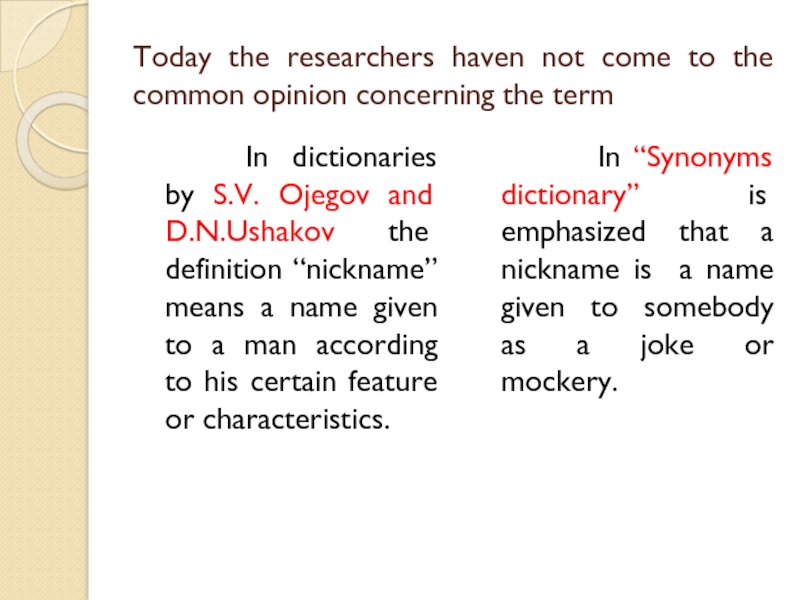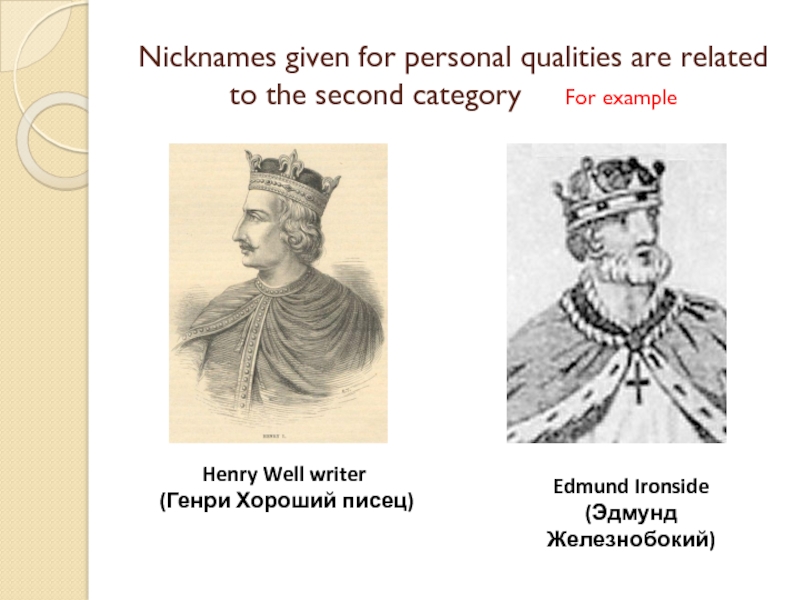Слайд 1Lisitsina Kseniya 7-A
Lyceum № 2
Yuzhno-Sakhalinsk
Слайд 2 English and British dynasties
Saxon dynasty
Danish dynasty
Anglo-saxon dynasty
Norman dynasyty
Plantagenet dynasty
Lancaster dynasty
.
York dynasty
Tudor dynasty
Stuart dynasty
Hanover dynasty
Windsor (before 1917 year –
Saxe- Coburg - Gotha) dynasty
Since the 9th century to nowadays the throne of Great Britain has been occupied by 11 royal dynasties:
Dynasties included 61monarch persons. A lot of them had nicknames and characteristing epithets
Слайд 3The nicknames and characteristing epithets of the royal persons and
the reason of their getting is going to be very
important , significant for the research because:
to know more about royal persons: their appearance and features of their character
to define the peculiarities of the rule of this or that monarch
to understand their life, customs, traditions and language better
to broad linguistic knowledge in the field of such science as onomastics
Слайд 4The purposes of our research are:
to defined of the British
Monarch’s characterising epithets and nicknames;
to descover the reason of
their getting
Слайд 5According to the purpose of our research there were find
the following problems:
To give the characteristic of monarch’s full name
and its separate parts;
To give the definition to the words “epithet” and “nickname” and define the difference between them;
To find out what kind of nicknames and characterising epithets British Monarchs had, determine the reasons of their getting;
Study the classification of the reasons according to which the nicknames and characterising epithets were given.
Слайд 6The object of the research paper is onomastics of the
English language.
The subject of the scientific research
is proper names consisted
of epithets
and nicknames which were given to the
English and British monarchs during
their reign.
Слайд 7The bibliography used while preparing the report, can be separated
into several groups:
reference- books and dictionaries;
scientific publications, which represent both
monographs and articles from magazines;
Manuals;
the Internet resources
Слайд 8Methods of scientific cognition were used:
analysis and synthesis
comparison
generalisation
classification
definition of concepts
Слайд 9The applied prospectively practical significance is
in using the material on
the lessons of English
elective courses in the English language
on extracurricular activities
the prepared presentation can be the basis for the advanced self-learning of the British History and the English languag.
Слайд 10Unit I.
Forms of a monarch’s name.
Nicknames and
сharacterising epithets
as a part of a monarch’s name
Слайд 11Monarchs and other royal representatives could have several names.
The
fullest name could be made up of a long line
of titles, epithets and nicknames.
For example:
The full name of the British King Henry IV sounds as:
Henry IV Lancaster, King of England, Earl of Derby,
Duke of Hereford, Bolingbroke.
Слайд 12The separate parts of the full name can be divided
into five main groups:
- Birth name – personal name;
- Throne
name is the name which a monarch person got becoming the king;
- Title name – includes a noble man’s title;
- Epithet stands for the tile name. When saying an epithet throne number is not use;
- Nicknames –nicknames given with the birth very oftenwere included into the full monarch’s name.
Слайд 13Henry IV
- King Henry IV
(according to the royal title)
-
Henry Lancaster
(according to the ancestral name)
- Henry IV English
(according to the throne name)
- Henry Hereford
(according to the Duke Hereford’s title)
- Henry Derby
(according to the Earl Derby’s title)
- Henry Bolingbroke
(a nickname according to the birth)
For example:
Слайд 14Richard Plantagenet,
Duke of Aquitania,
Earl D’ Puate,
King of England,
Duke
of Normandy,
Ear Andjuisky,
Turish and Manskiy
Richard the Lionheart (Львиное сердце)
For
example
Unit II.
Problem of concepts "nickname"
and "epithet" in modern linguistics
Слайд 16Today the researchers haven not come to the common opinion
concerning the term
In dictionaries by
S.V. Ojegov and D.N.Ushakov the definition “nickname” means a name given to a man according to his certain feature or characteristics.
In “Synonyms dictionary” is emphasized that a nickname is a name given to somebody as a joke or mockery.
Слайд 17For example
Ethelred the Unready
(Этельред Неразумный)
Henry
Blue Beard
(Генри Синяя Борода)
Слайд 18The classification gives rise to a discussion either
Differenr variants of
classifications are given in the Z.P. Nikulina, D.I. Ermolovich’s papers.
We have marked out those criteria of classification, which most researches had:
-according to appearance;
-according to personal qualities
Слайд 19
Richard III Crookback (Ричард Горбун)
The following British
Monarchs are related to the first category:
For example
Edward I Longshanks (Эдвард Длинноногий)
Слайд 20But it must be marked that not all nicknames revealed
the reality:
For example
Sweyn I Forkbeard
(Свен Вилобородый)
William II Rufus (Вильям Рыжий)
Слайд 21Nicknames given for personal qualities are related to the second
category For example
Henry Well writer
(Генри Хороший писец)
Edmund
Ironside
(Эдмунд Железнобокий)
Слайд 22There are some nicknames which can’t be related to the
categories given above For example
Richard
III Humpty- Dumpty (Ричард Шалтай-Болтай)
Henry VIII Old copper nose
(Генрих VIII Старый медный нос)
Слайд 23
Unit III.
Nicknames and characterising epithets of English and British
monarchs. The classification of the reasons of getting them.
Слайд 24The definitions “nickname” and “characterising epithet”
the difference is not so
distinct.
The theorists consider that an epithet emphasizes a person’s individuality.
It replaces the title name and throne number.
For example:
The Conqueror, the Great, the Saint
Слайд 25Edward the Confessor
(Эдуард Исповедник)
William I the Conqueror (Вильгельм Завоеватель)
Слайд 26Unit IV
Nicknames and characterising epithets of the British monarchs
now
Слайд 27 In the course of time the
real rule over the country went to the English Prime
Ministers, who stated getting nicknames and epithets as well as they were given to royal persons earlier.
Слайд 28The prime-ministers of Great Britain
Margaret Thatcher
Tony Blair
“Iron Lady” “Bushe,s poodle”
“Teflon Tony”
Слайд 29Gordon Brown
"The red is proud“
“Gold Brown"
David Cameron
«Direct David»
Слайд 30Elizabeth II «National grandmother» (Елизавета II «Национальная бабушка»)
Слайд 31Conclusion:
Nicknames and epithets play a very important part in the
British monarchs’ life. Some of them are the pride of
the country as they reflect the most important moments in its history.
Since 17th century nicknames and epithets have been given to the monarchs rarely. And now they are not used at all. The English prime- ministers are being given it.
In modern onomastics the problem of the definitions “nicknames” and “epithets” and its classification has not been solved yet. The unfinished state of the linguistic process is the sign of its constant development.


















































